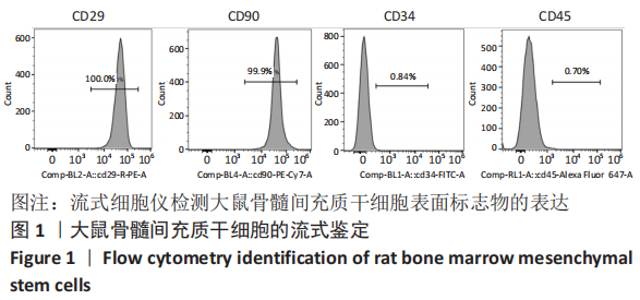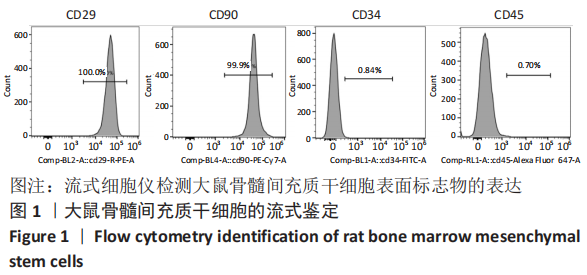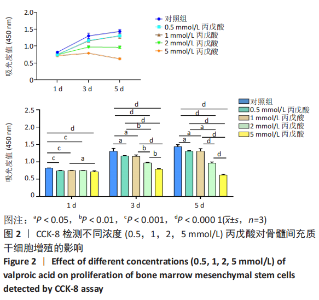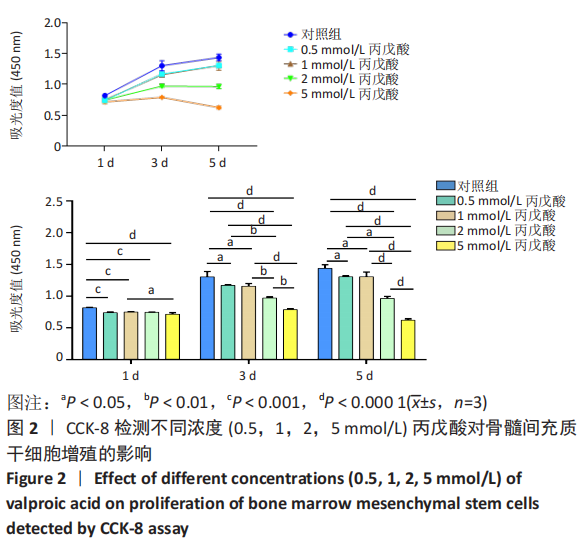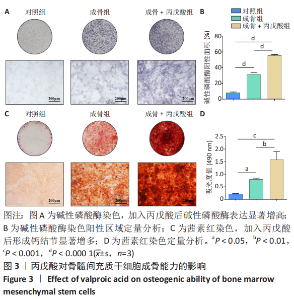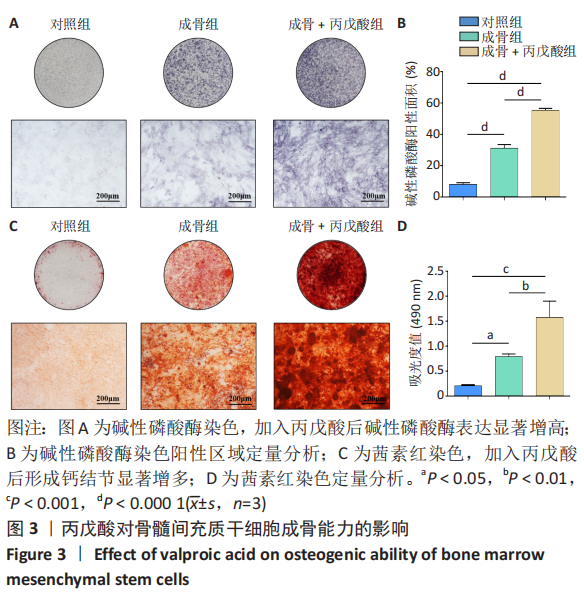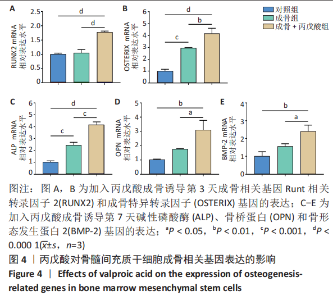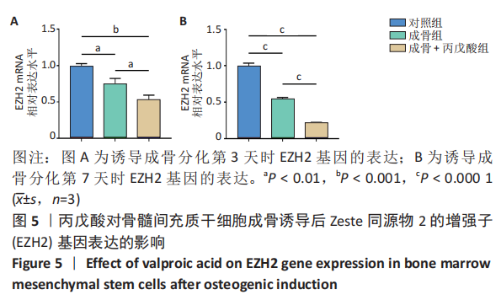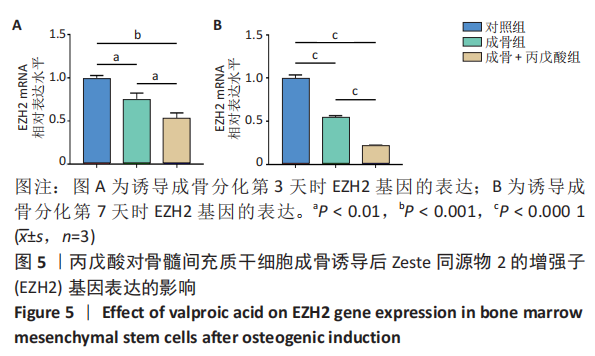Chinese Journal of Tissue Engineering Research ›› 2023, Vol. 27 ›› Issue (15): 2304-2310.doi: 10.12307/2023.365
Previous Articles Next Articles
Valproic acid promotes osteogenic differentiation of rat bone marrow mesenchymal stem cells
Ling Xuwei1, 2, Sun Jie1, 2, Liu Chang1, 2, Wang Yi1, 2, Shi Qin1, 2, Yang Huilin1, 2
- 1Department of Orthopedics, First Affiliated Hospital of Soochow University, Suzhou Medical College of Soochow University, Suzhou 215006, Jiangsu Province, China; 2Institute of Orthopedics, Soochow University, Suzhou 215006, Jiangsu Province, China
-
Received:2022-04-16Accepted:2022-06-22Online:2023-05-28Published:2022-10-17 -
Contact:Yang Huilin, Chief physician, Doctoral supervisor, Professor, Department of Orthopedics, First Affiliated Hospital of Soochow University, Suzhou Medical College of Soochow University, Suzhou 215006, Jiangsu Province, China; Institute of Orthopedics, Soochow University, Suzhou 215006, Jiangsu Province, China -
About author:Ling Xuwei, Master candidate, Physician, Department of Orthopedics, First Affiliated Hospital of Soochow University, Suzhou Medical College of Soochow University, Suzhou 215006, Jiangsu Province, China; Institute of Orthopedics, Soochow University, Suzhou 215006, Jiangsu Province, China -
Supported by:Ministry of Health’s “Science and Education Revitalizing Health” Project-Jiangsu Provincial Orthopedic Clinical Medical Center (to YHL)
CLC Number:
Cite this article
Ling Xuwei, Sun Jie, Liu Chang, Wang Yi, Shi Qin, Yang Huilin. Valproic acid promotes osteogenic differentiation of rat bone marrow mesenchymal stem cells[J]. Chinese Journal of Tissue Engineering Research, 2023, 27(15): 2304-2310.
share this article
Add to citation manager EndNote|Reference Manager|ProCite|BibTeX|RefWorks
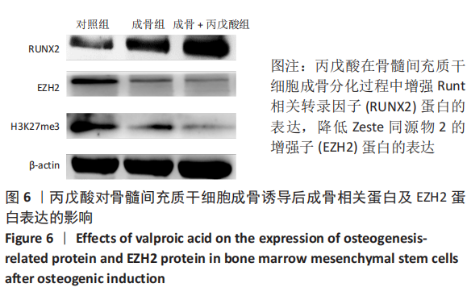
2.6 丙戊酸对骨髓间充质干细胞成骨诱导后成骨相关蛋白及EZH2蛋白表达的影响 为了进一步研究丙戊酸可以通过下调EZH2的表达来促进骨髓间充质干细胞成骨分化,在成骨诱导第5天,提取细胞蛋白进行Western blot实验以检测成骨相关蛋白RUNX2的表达,EZH2和H3K27me3的蛋白表达。根据Western blot实验的条带结果显示,在骨髓间充质干细胞成骨分化过程中加入丙戊酸后,EZH2表达降低,同时导致调控于EZH2的H3K27me3水平下调,成骨相关蛋白RUNX2表达显著提高,见图6。以上结果证实,丙戊酸可以下调EZH2及H3K27me3蛋白水平的表达,提高成骨转录因子RUNX2的活性来促进骨髓间充质干细胞的成骨分化。"
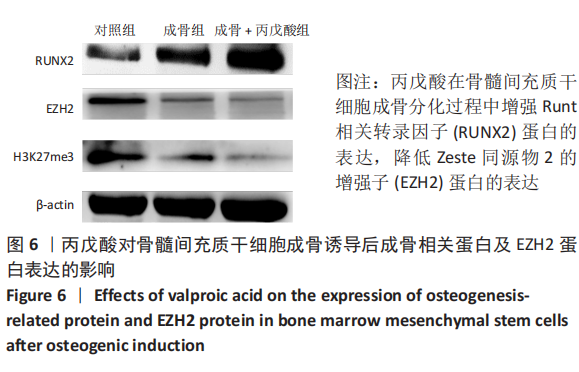
| [1] CHENG L, LI Y, XIA Q, et al. Enamel matrix derivative (EMD) enhances the osteogenic differentiation of bone marrow mesenchymal stem cells (BMSCs). Bioengineered. 2021;12(1):7033-7045. [2] ZHU Y, YE L, CAI X, et al. Icariin-Loaded Hydrogel Regulates Bone Marrow Mesenchymal Stem Cell Chondrogenic Differentiation and Promotes Cartilage Repair in Osteoarthritis. Front Bioeng Biotechnol. 2022;10:755260. [3] LIN W, CHEN Z, MO X, et al. Phactr1 negatively regulates bone mass by inhibiting osteogenesis and promoting adipogenesis of BMSCs via RhoA/ROCK2. J Mol Histol. 2022;53(1):119-131. [4] ZHANG H, ZHANG W, BAI G, et al. Bone Morphogenetic Protein-7 (BMP-7) Promotes Neuronal Differentiation of Bone Marrow Mesenchymal Stem Cells (BMSCs) In Vitro. Biomed Res Int. 2021;2021(3):1-9. [5] HANG HL, XIA Q. Role of BMSCs in liver regeneration and metastasis after hepatectomy. World J Gastroenterol. 2014;20(1):126-132. [6] SUN C, ZHANG AD, CHEN HH, et al. Magnet-targeted delivery of bone marrow-derived mesenchymal stem cells improves therapeutic efficacy following hypoxic-ischemic brain injury. Neural Regen Res. 2021;16(11):2324-2329. [7] LI YZ, LIU YJ, ZHANG W, et al. Combined treatment with valproic acid and estrogen has neuroprotective effects in ovariectomized mice with Alzheimer’s disease. Neural Regen Res. 2021;16(10):2078-2085. [8] PITETZIS DA, SPILIOTI MG, YOVOS JG, et al. The effect of VPA on bone: From clinical studies to cell cultures-The molecular mechanisms revisited. Seizure. 2017;48:36-43. [9] AKSHAYA N, PRASITH P, ABINAYA B, et al. Valproic acid, A Potential Inducer of Osteogenesis in Mouse Mesenchymal Stem Cells. Curr Mol Pharmacol. 2021;14(1):27-35. [10] HAN W, GUAN W. Valproic Acid: A Promising Therapeutic Agent in Glioma Treatment. Front Oncol. 2021;11:687362. [11] KITAZOE KI, ABE M, HIASA M, et al. Valproic acid exerts anti-tumor as well as anti-angiogenic effects on myeloma. Int J Hematol. 2009; 89(1):45-57. [12] SURAWEERA A, O’BYRNE KJ, RICHARD DJ. Combination Therapy With Histone Deacetylase Inhibitors (HDACi) for the Treatment of Cancer: Achieving the Full Therapeutic Potential of HDACi. Front Oncol. 2018; 8:92. [13] HUYNH NC, EVERTS V, AMPORNARAMVETH RS. Histone deacetylases and their roles in mineralized tissue regeneration. Bone Rep. 2017;7: 33-40. [14] CHO HH, PARK HT, KIM YJ, et al. Induction of osteogenic differentiation of human mesenchymal stem cells by histone deacetylase inhibitors. J Cell Biochem. 2005;96(3):533-542. [15] CHA H, LEE J, PARK HH, et al. Direct Conversion of Human Fibroblasts into Osteoblasts Triggered by Histone Deacetylase Inhibitor Valproic Acid. Applied Sciences. 2020;10(20):7372. [16] PAINO F, LA NOCE M, TIRINO V, et al. Histone deacetylase inhibition with valproic acid downregulates osteocalcin gene expression in human dental pulp stem cells and osteoblasts: evidence for HDAC2 involvement. Stem Cells. 2014;32(1):279-289. [17] YU Y, OH SY, KIM HY, et al. Valproic Acid-Induced CCN1 Promotes Osteogenic Differentiation by Increasing CCN1 Protein Stability through HDAC1 Inhibition in Tonsil-Derived Mesenchymal Stem Cells. Cells. 2022;11(3):534. [18] ZHOU D, CHEN YX, YIN JH, et al. Valproic acid prevents glucocorticoidinduced osteonecrosis of the femoral head of rats. Int J Mol Med. 2018;41(6):3433-3447. [19] HUANG J, GOU H, YAO J, et al. The noncanonical role of EZH2 in cancer. Cancer Sci. 2021;112(4):1376-1382. [20] PAPPAS K, MARTIN TC, WOLFE AL, et al. NOTCH and EZH2 collaborate to repress PTEN expression in breast cancer. Commun Biol. 2021;4(1): 312. [21] SAWICKA-GUTAJ N, SHAWKAT S, ANDRUSIEWICZ M, et al. EZH2 and SMYD3 expression in papillary thyroid cancer. Oncol Lett. 2021;21(5): 342. [22] XIN L. EZH2 accompanies prostate cancer progression. Nat Cell Biol. 2021;23(9):934-936. [23] LI C, SONG J, GUO Z, et al. EZH2 Inhibitors Suppress Colorectal Cancer by Regulating Macrophage Polarization in the Tumor Microenvironment. Front Immunol. 2022;13:857808. [24] GUI T, LIU M, YAO B, et al. TCF3 is epigenetically silenced by EZH2 and DNMT3B and functions as a tumor suppressor in endometrial cancer. Cell Death Differ. 2021;28(12):3316-3328. [25] DUDAKOVIC A, CAMILLERI ET, PARADISE CR, et al. Enhancer of zeste homolog 2 (Ezh2) controls bone formation and cell cycle progression during osteogenesis in mice. J Biol Chem. 2018;293(33):12894-12907. [26] CHEN L, WU Y, WU Y, et al. The inhibition of EZH2 ameliorates osteoarthritis development through the Wnt/beta-catenin pathway. Sci Rep. 2016;6:29176. [27] JING H, LIAO L, AN Y, et al. Suppression of EZH2 Prevents the Shift of Osteoporotic MSC Fate to Adipocyte and Enhances Bone Formation During Osteoporosis. Mol Ther. 2016;24(2):217-229. [28] GALVAN ML, PARADISE CR, KUBROVA E, et al. Multiple pharmacological inhibitors targeting the epigenetic suppressor enhancer of zeste homolog 2 (Ezh2) accelerate osteoblast differentiation. Bone. 2021; 150:115993. [29] DEDONI S, MARRAS L, OLIANAS MC, et al. Downregulation of TrkB Expression and Signaling by Valproic Acid and Other Histone Deacetylase Inhibitors. J Pharmacol Exp Ther. 2019;370(3):490-503. [30] SAJADPOOR Z, AMINI-FARSANI Z, TEIMORI H, et al. Valproic Acid Promotes Apoptosis and Cisplatin Sensitivity Through Downregulation of H19 Noncoding RNA in Ovarian A2780 Cells. Appl Biochem Biotechnol. 2018;185(4):1132-1144. [31] FU Y, ZHANG P, GE J, et al. Histone deacetylase 8 suppresses osteogenic differentiation of bone marrow stromal cells by inhibiting histone H3K9 acetylation and RUNX2 activity. Int J Biochem Cell Biol. 2014;54:68-77. [32] YI SJ, LEE H, LEE J, et al. Bone Remodeling: Histone Modifications as Fate Determinants of Bone Cell Differentiation. Int J Mol Sci. 2019; 20(13):3147. [33] ICARDI L, DE BOSSCHER K, TAVERNIER J. The HAT/HDAC interplay: multilevel control of STAT signaling. Cytokine Growth Factor Rev. 2012; 23(6):283-291. [34] VISHAL M, AJEETHA R, KEERTHANA R, et al. Regulation of Runx2 by Histone Deacetylases in Bone. Curr Protein Pept Sci. 2016;17(4):343-351. [35] HSIEH TH, HSU CY, TSAI CF, et al. HDAC inhibitors target HDAC5, upregulate microRNA-125a-5p, and induce apoptosis in breast cancer cells. Mol Ther. 2015;23(4):656-666. [36] PEREZ-CAMPO FM, SANTURTUN A, GARCIA-IBARBIA C, et al. Osterix and RUNX2 are Transcriptional Regulators of Sclerostin in Human Bone. Calcif Tissue Int. 2016;99(3):302-309. [37] HEMMING S, CAKOUROS D, ISENMANN S, et al. EZH2 and KDM6A act as an epigenetic switch to regulate mesenchymal stem cell lineage specification. Stem Cells. 2014;32(3):802-815. [38] SEN B, PARADISE CR, XIE Z, et al. beta-Catenin Preserves the Stem State of Murine Bone Marrow Stromal Cells Through Activation of EZH2. J Bone Miner Res. 2020;35(6):1149-1162. [39] DUDAKOVIC A, CAMILLERI ET, RIESTER SM, et al. Enhancer of Zeste Homolog 2 Inhibition Stimulates Bone Formation and Mitigates Bone Loss Caused by Ovariectomy in Skeletally Mature Mice. J Biol Chem. 2016;291(47):24594-24606. [40] ZHU L, XU PC. Downregulated LncRNA-ANCR promotes osteoblast differentiation by targeting EZH2 and regulating Runx2 expression. Biochem Biophys Res Commun. 2013;432(4):612-617. |
| [1] | Dang Yi, Du Chengyan, Yao Honglin, Yuan Nenghua, Cao Jin, Xiong Shan, Zhang Dingmei, Wang Xin. Hormonal osteonecrosis and oxidative stress [J]. Chinese Journal of Tissue Engineering Research, 2023, 27(9): 1469-1476. |
| [2] | Yang Zhishan, Tang Zhenglong. YAP/TAZ, a core factor of the Hippo signaling pathway, is involved in bone formation [J]. Chinese Journal of Tissue Engineering Research, 2023, 27(8): 1264-1271. |
| [3] | Liu Wentao, Feng Xingchao, Yang Yi, Bai Shengbin. Effect of M2 macrophage-derived exosomes on osteogenic differentiation of bone marrow mesenchymal stem cells [J]. Chinese Journal of Tissue Engineering Research, 2023, 27(6): 840-845. |
| [4] | Long Yanming, Xie Mengsheng, Huang Jiajie, Xue Wenli, Rong Hui, Li Xiaojie. Casein kinase 2-interaction protein-1 regulates the osteogenic ability of bone marrow mesenchymal stem cells in osteoporosis rats [J]. Chinese Journal of Tissue Engineering Research, 2023, 27(6): 878-882. |
| [5] | Li Xinyue, Li Xiheng, Mao Tianjiao, Tang Liang, Li Jiang. Three-dimensional culture affects morphology, activity and osteogenic differentiation of human periodontal ligament stem cells [J]. Chinese Journal of Tissue Engineering Research, 2023, 27(6): 846-852. |
| [6] | Li Qicheng, Deng Jin, Fu Xiaoyang, Han Na. Effects of bone marrow mesenchymal stem cells-derived exosomes on hypoxia-treated myoblasts [J]. Chinese Journal of Tissue Engineering Research, 2023, 27(6): 853-859. |
| [7] | Wang Min, Yin Xiushan, Wang Yingxi, Zhang Yan, Zhao Long, Xia Shuyue. Inhalation of bone marrow mesenchymal stem cells-derived exosomes alleviates inflammatory injury in chronic obstructive pulmonary disease [J]. Chinese Journal of Tissue Engineering Research, 2023, 27(6): 827-834. |
| [8] | Yuan Wei, Liu Jingdong, Xu Guanghui, Kang Jian, Li Fuping, Wang Yingjie, Zhi Zhongzheng, Li Guanwu. Osteogenic differentiation of human perivascular stem cells and its regulation based on Wnt/beta-catenin signaling pathway [J]. Chinese Journal of Tissue Engineering Research, 2023, 27(6): 866-871. |
| [9] | Li Rui, Liu Zhen, Guo Zige, Lu Ruijie, Wang Chen. Aspirin-loaded chitosan nanoparticles and polydopamine modified titanium sheets improve osteogenic differentiation [J]. Chinese Journal of Tissue Engineering Research, 2023, 27(3): 374-379. |
| [10] | Dai Xianglin, Zhang Wenfeng, Yao Xijun, Shang Jiaqi, Huang Qiujin, Ren Yifan, Deng Jiupeng. Barium titanate/polylactic acid piezoelectric composite film affects adhesion, proliferation, and osteogenic differentiation of MC3T3-E1 cells [J]. Chinese Journal of Tissue Engineering Research, 2023, 27(3): 367-373. |
| [11] | He Zike, Wang Shangzeng. Eucommia ulmoides Oliver aqueous extract promotes bone marrow mesenchymal stem cell proliferation and osteoblastic differentiation through upregulating Nur77 protein expression [J]. Chinese Journal of Tissue Engineering Research, 2023, 27(15): 2371-2378. |
| [12] | Yang Jun, Li Peng. Differentiation of bone marrow mesenchymal stem cells into meniscus fibrochondrocytes induced by transforming growth factor beta [J]. Chinese Journal of Tissue Engineering Research, 2023, 27(15): 2412-2419. |
| [13] | Wen Hongjie, Chen Zhong, Yang Huagang, Xu Yongqing. Transcriptome sequencing analysis of osteogenic rat bone marrow mesenchymal stem cells induced by osteomyelitis [J]. Chinese Journal of Tissue Engineering Research, 2023, 27(15): 2333-2338. |
| [14] | Zhu Can, He Jiaheng, Chen Chichi, Liu Bo, Luo Zongping, Sun Jie, Shi Qin. Chlorogenic acid promotes osteogenic differentiation of osteoblast precursor cells [J]. Chinese Journal of Tissue Engineering Research, 2023, 27(14): 2170-2175. |
| [15] | Ling Huajun, Cui Ruiwen, Wang Qiyou. 3D extracellular matrix hydrogel loaded with exosomes promotes wound repair [J]. Chinese Journal of Tissue Engineering Research, 2023, 27(12): 1900-1905. |
| Viewed | ||||||
|
Full text |
|
|||||
|
Abstract |
|
|||||
